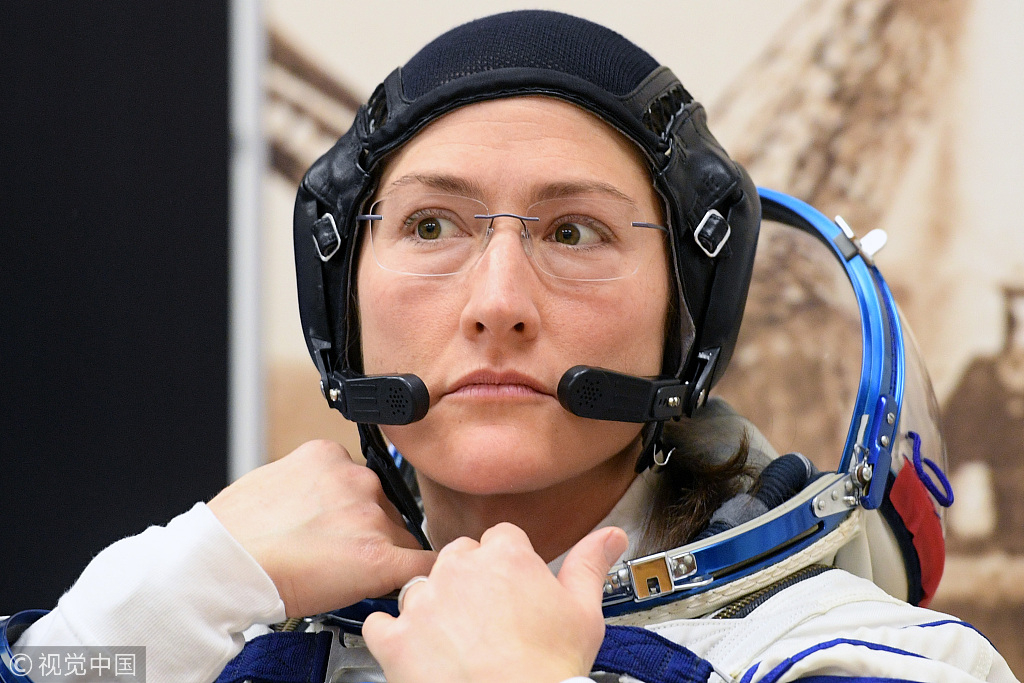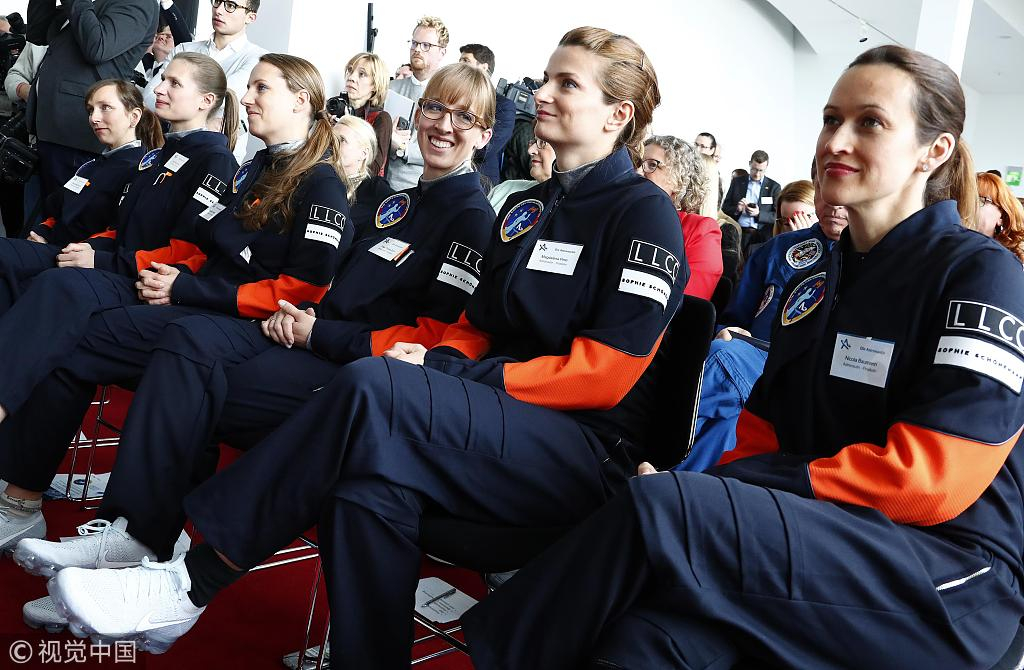
Opinion
12:22, 29-Mar-2019
From women in space to women in tech: The paradox of visibility
Aaron Zou

Editor's note: Aaron Zou is a California-based PhD student specializing in media and cultural studies. The article reflects the author's opinion and not necessarily the views of CGTN.
The first all-female spacewalk was scheduled for March 29 outside the International Space Station, but was scrapped due to the shortage of spacesuits in the correct size. And according to the latest report, one female has been replaced with a male who can wear a larger suit for the planned spacewalk.
Astronauts Anne McClain and Christina Koch were initially set to work together in spacesuits on this mission, while being supported by a female flight controller on the ground. The goal of the spacewalk is to upgrade the space station's power system with new batteries. Although a NASA spokesperson said that the original plan for the all-female spacewalk “was not orchestrated to be this way” and was more of a result of scheduling shifts and the changing makeup of the crew, this mission, once publicized, garnered widespread attention and acclaim, with some calling it a milestone for women in the field of space exploration and beyond.
Although the all-female spacewalk is not happening this week, people are still waiting for the long overdue all-female spacewalk to happen, a milestone to be looked forward to.
Women in space
Women have traditionally been marginalized in space flight programs, with their contribution to the field neglected or overshadowed. Space flight programs worldwide have been generally slow in employing women. NASA opened the space program to female applicants in 1978, while some other agencies began to include women in the 1980s. As Guardian reports, fewer than 11 percent of the more than 500 people who have traveled to space have been female, and spacewalk teams have comprised of either all males or both male and female members. Women tended to often serve as assistants to male astronauts who conducted the spacewalk.

NASA astronaut Christina Hammock Koch looks on as her spacesuit is tested prior to the launch on board the Soyuz MS-12 spacecraft from the Russian-leased Baikonur cosmodrome in Kazakhstan, March 14, 2019. /VCG Photo
NASA astronaut Christina Hammock Koch looks on as her spacesuit is tested prior to the launch on board the Soyuz MS-12 spacecraft from the Russian-leased Baikonur cosmodrome in Kazakhstan, March 14, 2019. /VCG Photo
However, women astronauts' visible contribution to space missions started as early as the 1960s, when Soviet female astronaut Valentina Tereshkova flew to space. Following her lead, Svetlana Savitskaya became the second woman to fly to space in 1982, and the first female to carry out a spacewalk in 1984. In the following years, more women astronauts emerged, such as Judith Resnik and Christa McAuliffe.
There has been a notable increase in the presence of women in space flight programs across the board. Indeed, the possibility of an all-female spacewalk is largely attributable to the change in the makeup of space crews. Both McClain and Koch were part of the 2013 astronaut candidate class, and of the eight candidates selected in 2013, half of them were women. According to NASA, the most recent class of flight directors was also 50 percent women. China, Russia and the U.S. maintain active space programs that have included women. In 2012, Liu Yang became the first female Chinese astronaut to fly to space. More and more women astronauts have worked at the International Space Station in recent years.
Women at work
The increasing presence of women in space programs counters the misconceived stereotype that women aren't cut out for the job. Gender stereotypes of this sort not only existed in space flight programs, but many other fields as well. American scholar Jennifer Light, in her work "When Computers Were Women," detailed how women were rendered invisible from the early history of computing in the U.S. She retells the historical story of the development of America's first electronic computer with a special focus on female technicians who made intellectually significant contributions to the field. The job of programming, often perceived as masculine work, according to her account, started as feminized labor. However, women's role in computation was trivialized and discredited in media coverage and public discourse.
The male-dominated culture still pervades today's tech sector, from Silicon Valley giants to entrepreneurial startups scattered across the globe. Glass ceilings remain an elephant in the room for tech companies. The underpinning ethos of the corporate culture in the tech world – which includes the normalization of risks and precarity, the ceaseless cycle of work and innovation and the masculine geek culture – all tend to work to the disadvantage of women who are often expected to move back and forth between professional roles and their gendered roles as a mother, a wife and a feminine figure in general.

Applicants attend a media event where German Economy Minister Brigitte Zypries will present Germany's first female astronauts at the Brandenburg Gate in Berlin, Germany, April 19, 2017. /VCG Photo
Applicants attend a media event where German Economy Minister Brigitte Zypries will present Germany's first female astronauts at the Brandenburg Gate in Berlin, Germany, April 19, 2017. /VCG Photo
The contradictory expectations that women struggle to meet, coupled with the male-dominated corporate culture and norms, made it more challenging for women to receive professional recognition and accolades. When they do, they risk being seen as abnormal – discrimination at a different level. Admittedly, successful women are acclaimed, too, but they are often few and far between. Sheryl Sandberg is often celebrated as an iconic figure for women in tech and beyond, but her case does not represent the general plight of women professionals in the industry.
A milestone yet to be achieved
The paradox of the increasing visibility assigned to professional women is self-evident. On the one hand, we want to see more women succeed in all walks of life; on the other, when some women succeed, they become the poster-children of professional women, which both points to and glosses over the structural inequality that still pervades the professional world. An all-female spacewalk would indeed be a milestone for women insofar as more women are becoming visible and receiving the recognition they deserve.
Nonetheless, a greater milestone is yet to be achieved when we are not just celebrating the handful of successful women as icons, but rather looking at whether the plight for all women professionals has improved generally; a greater milestone is yet to be achieved when even a few successful women are not seen as extraordinary, but as normal and equal to their male counterparts; a greater milestone is yet to be achieved when we are not amazed at the fact that a spacewalk could possibly be conducted by an all-female crew, and when it does not become a trending news topic any longer. That is the milestone to which we are really looking forward.
(Cover photo: NASA astronaut Christina Koch (center) assists fellow astronauts Nick Hague (left) and Anne McClain in their U.S. spacesuits shortly before they begin the first spacewalk of their careers. /VCG Photo)
(If you want to contribute and have specific expertise, please contact us at opinions@cgtn.com.)

SITEMAP
Copyright © 2018 CGTN. Beijing ICP prepared NO.16065310-3
Copyright © 2018 CGTN. Beijing ICP prepared NO.16065310-3